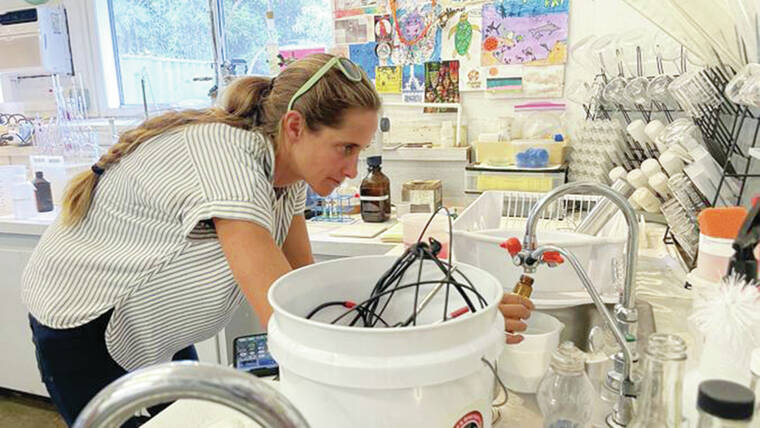LAHAINA, Hawai‘i — As West Maui continues to pick up the pieces in the aftermath of Hawai‘i’s deadliest wildfires on record, a University of Hawai‘i team has begun working to address the threat of water contamination — a critical step in the region’s long road to recovery.
The UH Manoa Water Resources Research Center (WRRC) is leading the effort. Less than two weeks after the Aug. 8 fires, the center launched the Maui Post-Fire Community Drinking-Water Information Hub to assist residents in understanding water quality updates as they occur.
Simultaneously, WRRC hydrologist Chris Schuler paired up with Purdue University fire disaster specialist and UH graduate students to form a volunteer-run, tap-water quality testing and outreach program.
“We realized there was an information gap,” said Chris Schuler, a hydrologist with WRRC. “We responded to that need by developing an information hub to help put all of the information in one place that is easily accessible for people. Another part of our response includes a request form, where Maui residents can ask WRRC to take samples of their drinking water to test for contaminants.”
Among the damage caused by the fires, which killed at least 115 people and razed much of Lahaina, were hundreds of drinking water pipes. Such damage to the water system creates a drop in the system’s pressure, which can allow for metals, bacteria and other dangerous contaminants created by high temperatures to enter.
“One of the things that’s been seen in California is the intake of smoke and benzene, or other volatile organic chemicals that get sort of sucked into the water supply when the water mains break under fire and there’s a lot of smoke and other noxious gases floating around,” state toxicologist Diana Felton told The Garden Island shortly after the August fires. “So those are the main things we’re thinking about.”
The Maui Department of Water Supply issued a water advisory about 36 hours after Kula residents were allowed to return home
The WRRC team has collected samples from both Lahaina and Kula that are being tested for contaminants in labs on Maui and O‘ahu. As of Aug. 27, a total of 10 samples have been tested, with about 60 more currently headed to the labs.
While the fires are unprecedented in Hawai‘i’s history, concerns over water contamination in Hawai‘i are not, allowing WRRC to transfer its existing framework to Maui with relative speed and ease.
“We were able to quickly respond to the terrible disaster in Maui because the testing and communications infrastructure was already in place from WRRC’s response to the Red Hill water contamination crisis on O‘ahu,” said WRRC director Thomas Giambelluca.
“The day after fire devastated Lahaina and parts of Kula, we were asking ourselves how we could help — and fortunately Chris Shuler, who is based on Maui, was already on the island and got the process started immediately.”
While the testing program is not a part of the state or county’s regulatory decision-making process, the team hopes their efforts can assist in building community trust by providing residents and the county the information needed to decide when the water is once again safe to drink.
“It has developed a lot of connections between scientists, environmental scientists and people on Maui and in Manoa, because everyone is united on a common goal toward response and recovery,” Schuler said.
“We are working at the community level with the sampling program, but WRRC has also had an impact at the county level in working with the Department of Water Supply and helping provide expertise with Whelton, who has responded to fires on the mainland.”
The UH team has said the program will remain in place for as long as it is needed.
•••
Jackson Healy, reporter, can be reached at 808-647-4966 or jhealy@thegardenisland.com.




